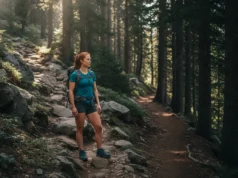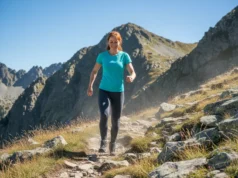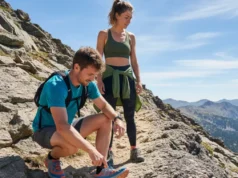In this article
Imagine packing for a trip to Peru. In your bag is a pair of rugged trail shoes for the Salkantay Trek, a comfortable pair for exploring the cobblestone streets of Cusco, and maybe even a lightweight camp shoe. What if one pair could do it all—and pack down small enough to leave room for souvenirs? The search for the best walking shoes for women often feels like a compromise, but today’s footwear technology has made the “one-shoe quiver” a reality. This guide is your map to finding that perfect pair of women’s walking shoes, moving beyond marketing hype to deliver a data-driven framework for choosing footwear that excels on varied terrain and disappears in your luggage.
- Learn the Code: We’ll demystify the six key performance factors—from cushioning to packability—that define great multi-terrain walking shoes.
- Persona-Driven Picks: Forget generic “best of” lists. We recommend specific shoes tailored to three distinct hiker archetypes: The Globetrotting Thru-Hiker, The Trail-to-Town Warrior, and The Comfort-First Fitness Walker.
- Data, Not Hype: Every recommendation is backed by quantitative scores, objective specifications, and insights from our expert testing protocols, principles of sports medicine, and an understanding of women-specific biomechanics.
- The Right Fit for Your Trip: Ultimately, you’ll learn how to choose a shoe that not only fits your foot but also perfectly fits the demands of your unique adventures.
How to Choose the Right Walking Footwear for Women: An Expert’s Framework
To make a smart, confident choice, you need to think like a gear tester. This framework will arm you with the objective knowledge to decode technical jargon and turn you from a passive buyer into an informed evaluator of your own needs, considering everything from your arch type to potential foot-swelling on long days.
Why Do Cushioning & Impact Absorption Matter?
Every step you take sends a shockwave up your kinetic chain, from your feet to your knees, hips, and lower back. Cushioning is the shoe’s primary defense against this repetitive impact. Located in the midsole, this layer of foam is what prevents fatigue and reduces the risk of overuse injuries. The cushioning foam type itself comes in a few key varieties. Traditional compression-molded EVA is lightweight and soft but can compress and “pack out” over time.
Modern foams like Boost, Pwrrun, or PEBA offer more energy return, while nitrogen-infused compounds like DNA Loft v3 provide a unique combination of softness and durability. This results in a ride that is incredibly light, soft, and plush yet responsive. The overall amount of this material is called the stack height—the distance between your foot and the ground. A high stack offers max cushioning, while a low stack gives you a better feel for the trail. Many designs now incorporate a rockered sole (like Hoka’s Meta-Rocker geometry) to promote a smoother stride. For a deeper dive into this, it’s worth understanding the different types of hiking footwear.
But the plushest cushion isn’t always the most stable, which is critical when the ground gets unpredictable.
How Critical is Stability & Support?
When you’re walking on a root-covered trail or an uneven cobblestone street, stability is what keeps your foot from rolling and helps prevent a trip-ending ankle sprain. This isn’t just about arch support; it’s about the entire shoe’s architecture working to manage pronation and keep your foot secure. Three features are critical here: a firm heel counter that cups and locks your heel in place, a wide base for a solid foundation, and torsional rigidity. A shoe with a firm midfoot provides crucial ankle support. It’s a myth that max cushioning equals max support. An excessively soft foam can feel wobbly unless the shoe’s design compensates for it, often with a women-specific last built to match female foot morphology, which is crucial for those with flatter feet. For guidance on products that promote foot health, the American Podiatric Medical Association’s Seal Program is an excellent resource.
Once your foot is stable, the shoe’s outsole needs to keep you connected to the ground.
What Makes for True Multi-Terrain Traction?
Traction is the critical interface between you and the world, and it all comes down to the design of the outsole. The specific shape, depth, and pattern of the rubber protrusions, called lugs, determine how well a shoe grips. Deep, aggressive lugs are designed to bite into soft ground like mud, while shallower lugs provide more rubber contact for gripping hard surfaces like asphalt, gravel, or a wet boardwalk, creating a truly slip-resistant outsole. The rubber compound itself is just as important. Premium compounds like Vibram Megrip are a hallmark of superior, long-lasting grip. For hikers, a heel brake is key for controlling speed on steep descents. These are just a few of the key features of good trekking shoes.
A great outsole won’t matter if the rest of the shoe falls apart.
How Can I Judge a Shoe’s Durability?
A shoe’s lifespan is largely determined by its materials and construction. The upper material faces a constant battle with abrasion. Modern synthetics, like engineered mesh, are light and breathable, but need reinforcement like TPU overlays. A rubber toe cap is also non-negotiable for protecting your feet. It’s also worth looking for brands with strong sustainability credentials, which may include features like a recycled upper or the use of vegan glue. On the bottom of the shoe, look for extensive rubber coverage on the outsole to prevent the soft midsole foam from getting shredded on hard surfaces. Learning about how leather impacts a boot’s durability and break-in period can provide valuable context on material trade-offs.
Pro-Tip: Check the stitching, especially where different materials meet. Double-stitched seams and clean, well-bonded overlays are a good indicator of quality manufacturing and a longer-lasting shoe.
But the most durable materials are often the least breathable, creating a critical trade-off for foot health.
Why Should I Care About Breathability & Climate Control?
Managing heat and moisture inside your shoe is the single most important factor in preventing blisters. For the best summer walking shoes, a breathable mesh upper with a high breathability score is essential for ventilation. The alternative is a waterproof membrane like Gore-Tex (GTX), which is a key feature for the best winter walking shoes. A GTX liner blocks external water but always reduces breathability, which can lead to sweaty feet in warm, dry conditions. Understanding this waterproofing trade-off is crucial. It’s vital to understand the trade-off between keeping water out and letting sweat escape when choosing your footwear.
Finally, for travelers, the best shoe is one you don’t even notice when it’s in your pack.
What is Packability & Why is it a Game-Changer for Travelers?
Packability is the metric that truly unlocks the “one-shoe quiver” for travel. It’s a combination of weight, compressibility, and packed volume, all of which contribute to a shoe’s packability score. Lighter shoes reduce luggage weight, but more importantly, flexible materials allow a shoe to be compressed or flattened, saving space. This is the defining feature of the best travel walking shoes, allowing you to pack one highly capable pair without sacrificing half your luggage space. Mastering this concept is key to learning how to effectively pack a backpack for any adventure.
Now that you’re armed with the knowledge to judge any shoe, let’s show you how we applied this framework to find the best of the best.
Our Selection Process: How We Built This Guide
To build a guide you can truly trust, we started not with a list of popular shoes, but with a scientific foundation. Our process is rooted in comprehensive lab and field testing, analysis of expert protocols, biomechanical recommendations, and feedback from our wear-testers.
Every walking shoe we considered was systematically scored against the six critical performance attributes you just learned about: Cushioning, Stability, Traction, Durability, Breathability, and Packability, including tracking the tester mileage logged.
Our selection process occurred in two distinct phases. First, we identified dozens of top-rated candidates. Second, we filtered that extensive list through the specific lens of three distinct user personas. This ensures our final recommendations aren’t just generically “good,” but are the right choice for a specific lifestyle footwear need, whether you’re trekking in the Andes or logging fitness miles in your neighborhood.
A quick note: If you choose to purchase a product through a link in this article, we may earn a small commission at no extra cost to you. This helps support our independent research and testing. We only recommend products we genuinely believe are the best in their class for a specific purpose.
The Best Women’s Walking Footwear of 2025: Our Top Recommendations for Every Need
Our Top Picks for “The Globetrotting Thru-Hiker”
This adventurer needs one ultralight, packable, and quick-drying shoe to conquer everything from technical alpine trails across desert sand to the cobblestone streets of a foreign city. For these multi-day trips, a Thru-Hiker Approved shoe with a high packability score is paramount.
Our Top Picks for “The Weekend Trail-to-Town Warrior”
This user is active and versatile. She needs a single, stylish shoe that can handle a Saturday morning hike and look right at home afterward. This is the ultimate trailhead to grocery run shoe, prioritizing trail-to-sidewalk grip and durability for use as everyday shoes.
Our Top Picks for “The Comfort-First Fitness Walker”
For this user, the primary goal is pain-free steps, mile after mile, on hard pavement. They need supportive walking shoes with max cushioning for conditions like plantar fasciitis, or during pregnancy. These are often the best work walking shoes for those on their feet for 12-hour work shifts. For specific needs like diabetes, walkers should look for shoes like New Balance diabetic shoes that meet the A5500 diabetic code. This category demands excellent podiatrist-certified arch support and a variety of width offerings, from narrow width to wide width and even 4E width.
Pro-Tip: If you’re buying shoes to help with a specific condition like plantar fasciitis, always try them on at the end of the day when your feet are most swollen to ensure you get an accurate and comfortable fit for your longest walks.
Conclusion
The “perfect” walking shoe doesn’t exist; the right shoes are a match between their design and your specific needs. For travel, a balance of Packability and Multi-Terrain Traction is key to a successful “one-shoe” strategy. For fitness walking, prioritizing maximum Cushioning and certified Stability is non-negotiable for long-term foot health. Above all, always prioritize fit over features. A supportive shoe with perfect specs is useless if it causes blisters or discomfort.
The trail, the city, and your next adventure await. Use this guide to choose your perfect active footwear with confidence, and then share your experience in the comments below—what shoe did you pick and where is it taking you?
Frequently Asked Questions about Women’s Walking Footwear
How is women’s walking footwear different, and how often should I replace it?
Women’s walking shoes are not just scaled-down men’s shoes. They are built on a women-specific last that accounts for key differences in foot morphology—typically a narrower heel and wider forefoot. This is why getting the right fit is crucial. As for replacement, there’s no magic number, but a good rule of thumb is to consider replacing your walking shoes every 300-500 miles. A more practical sign is when the cushioning feels flat or you start to feel new aches in your ankles or knees after a walk.
What does the APMA Seal of Acceptance mean and why is it important?
The American Podiatric Medical Association (APMA) Seal of Acceptance is a certification awarded to products found to be beneficial to foot health after a rigorous scientific review by a DPM podiatrist. For walkers, especially those managing conditions like plantar fasciitis or who need an orthotic friendly shoe with good orthotic compatibility, choosing a model with the APMA seal—such as the Hoka Bondi 9 or Saucony Echelon 10—provides an extra layer of confidence.
Can I just use my running shoes for walking?
Absolutely. In fact, many of the best running shoes for walking are excellent choices. They are lightweight, well-cushioned, and engineered for forward motion. Many high-cushion models like the Hoka Clifton 10 or Brooks Glycerin Max are fantastic for power-walking, while versatile trainers like the Nike Pegasus 41 or Adidas Ultraboost 5X are great all-rounders. Their rockered sole designs often create a smooth heel-to-toe transition that’s very efficient for a walking stride.
How important is the heel-to-toe drop for walking?
Heel-to-toe drop is a highly personal aspect of shoe fit that depends on your individual biomechanics. A higher drop (typically 8-12mm) places more cushioning under the heel and can help reduce strain on the Achilles tendon and calf muscles. This can be beneficial for those with a history of Achilles tendonitis or tight calves. Conversely, a lower drop (0-4mm), like that found in the Altra Lone Peak 8, encourages a more natural, midfoot-striking gait. There’s no single “best” drop; it’s about what feels most comfortable and natural for your body.
Risk Disclaimer: Hiking, trekking, backpacking, and all related outdoor activities involve inherent risks which may result in serious injury, illness, or death. The information provided on The Hiking Tribe is for educational and informational purposes only. While we strive for accuracy, information on trails, gear, techniques, and safety is not a substitute for your own best judgment and thorough preparation. Trail conditions, weather, and other environmental factors change rapidly and may differ from what is described on this site. Always check with official sources like park services for the most current alerts and conditions. Never undertake a hike beyond your abilities and always be prepared for the unexpected. By using this website, you agree that you are solely responsible for your own safety. Any reliance you place on our content is strictly at your own risk, and you assume all liability for your actions and decisions in the outdoors. The Hiking Tribe and its authors will not be held liable for any injury, damage, or loss sustained in connection with the use of the information herein.
Affiliate Disclosure: We are a participant in the Amazon Services LLC Associates Program, an affiliate advertising program designed to provide a means for us to earn advertising fees by advertising and linking to Amazon.com. As an Amazon Associate, we earn from qualifying purchases. We also participate in other affiliate programs and may receive a commission on products purchased through our links, at no extra cost to you. Additional terms are found in the terms of service.





